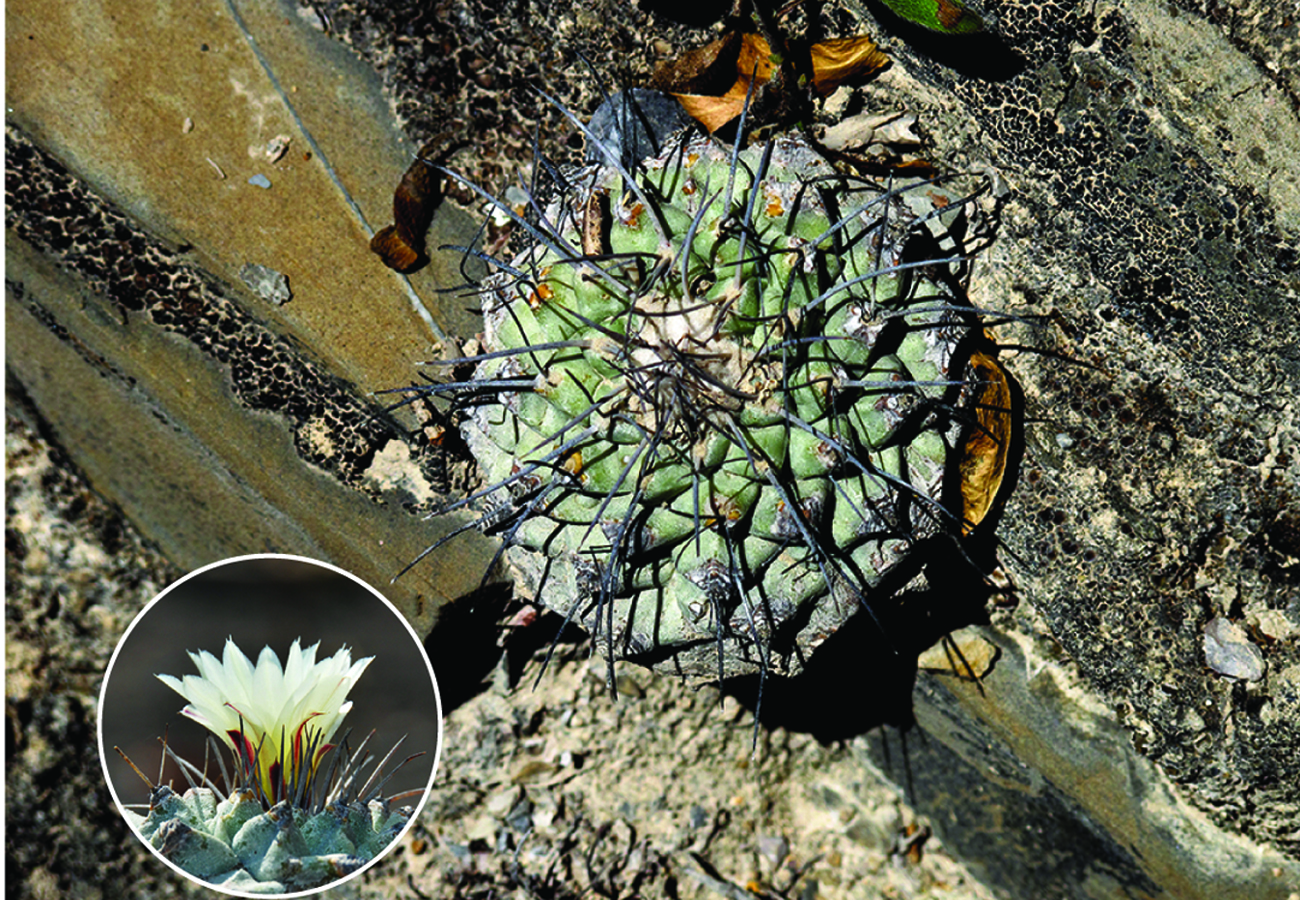Abstract
Molecular characterisation of the three taxa currently circumscribed under Strombocactus (Cactaceae, Cactoideae) based on the analysis of the plastid matK, psbA-trnH and atpB-rbcL datasets, provided unambiguous identification of the two endangered and highly wanted cacti species: S. corregidorae and S. disciformis (including subsp. disciformis and subsp. esperanzae). The combined autapomorphies in each of the three markers and even the autapomorphies in each of the single molecular datasets provide a positive and clear-cut identification for each of the taxa. The Bayesian, maximum likelihood and parsimony phylogenetic analyses of the three datasets including 46 terminals of cacti, recover a paraphyletic Strombocactus with S. corregidorae as sister to a clade containing Ariocarpus, Turbinicarpus, and Strombocactus disciformis subsp. disciformis + subsp. esperanzae. Autapomorphies for each of the three taxa for every dataset are identified, and as a consequence, the new genus Chichimecactus, based on S. corregidorae, is proposed.
References
<p>Anderson, E.F. (2001) The Cactus Family. Timber Press, Cambridge, 776 pp.<br>Anderson, E.F. & Skillman, S.M. (1984) A Comparison of Aztekium and Strombocactus (Cactaceae). Systematic Botany 9: 42–49. https://doi.org/10.2307/2418405 <br>Arias, S. & Sánchez-Martínez, E. (2010) Una nueva especie de Strombocactus (Cactaceae) from the Moctezuma River, Querétaro, Mexico. Revista Mexicana de Biodiversidad 81: 619–624. http://dx.doi.org/10.22201/ib.20078706e.2010.003.633<br>Bárcenas, R.T. (2003) Chihuahuan Desert Cacti in Mexico: an assessment of trade, management, and conservation priorities. In: Robbins, C.S. (Ed.) Prickly trade: trade and conservation of Chihuahuan Desert cacti. TRAFFIC North America, Washington D.C., pp. 1–65. <br>Bárcenas, R.T. (2016) A molecular phylogenetic approach to the systematics of Cylindropuntieae (Opuntioideae, Cactaceae). Cladistics 32: 335–478. https://doi.org/10.1111/cla.12135<br>Bárcenas, R.T., Yesson, C.J. & Hawkins, J.A. (2011) Molecular Systematics of the Cactaceae. Cladistics 27: 470–489. https://doi.org/10.1111/j.1096-0031.2011.00350.x<br>Barthlott, W. & Hunt, D. (2000) Seed Diversity in the Cactaceae Subfamily Cactoideae, David Hunt, Sherborne, 173 pp.<br>Britton, N.L. & Rose, J.N. (1922a) The Cactaceae, vol. 3. Carnegie Institution of Washington, Washington, D.C., 236 pp.<br>Britton, N.L. & Rose, J.N. (1922b) Two new genera of Cactaceae. Bulletin of the Torrey Botanical Club 49: 251. https://doi.org/10.2307/2480247<br>Camacho-Velázquez, A., Arias, S., García-Campusano, F., Sánchez-Martínez, E. & Vázquez-Santana, S. (2018) Seed development and germination of Strombocactus species (Cactaceae): A comparative morphological and anatomical study. Flora 242: 89–101. https://doi.org/10.1016/j.flora.2018.03.006<br>Camacho-Velázquez, A., Arias, S., Márquez-Guzmán, J. & Vázquez-Santana, S. (2019) The structure of nectaries in the genus Strombocactus (Cactaceae). Botanical Sciences 97: 100. https://doi.org/10.17129/botsci.2077<br>Candolle, A.P. de (1828) Reveu de la famille des cactées. Mémoires du Muséum d’histoire naturelle 17: 1–114. [https://www.biodiversitylibrary.org/page/26229066#page/124/mode/1up]<br>CITES (1973) The CITES Appendices, Washington. Available from: http://www.cites.org/eng/app/index.shtml (accessed 10 July 2021)<br>Coulter, J.M. (1894) Preliminary revision of the North American species of cactus, Anhalonium, and Lophophora. Contributions from the United States National Herbarium 3 (2): 91–132. <br>Glass, C. & Arias, S. (1996) A new subspecies of Strombocactus from the Sierra Gorda in the northeastern portion of the state of Guanajuato, Mexico. British Cactus & Succulent Journal 14: 200–204. <br>Goettsch, B., Hilton-Taylor, C., Cruz-Piñón, G., Duffy, J.P., Frances, A., Hernández, H.M., Inger, R., Pollock, C., Schipper, J., Superina, M., Taylor, N.P., Tognelli, M., Abba, A.M., Arias, S., Arreola-Nava, H.J., Baker, M.A., Bárcenas, R.T., Barrios, D., Braun, P., Butterworth, C.A., Búrquez, A., Caceres, F., Chazaro-Basañez, M., Corral-Díaz, R., Perea, M. del. V., Demaio, P.H., de Barros, W.A.D., Durán, R., Yancas, L.F., Felger, R.S., Fitz-Maurice, B., Fitz-Maurice, W.A., Gann, G., Gómez-Hinostrosa, C., Gonzales-Torres, L.R., Griffith, M.P., Guerrero, P.C., Hammel, B., Heil, K.D., Hernández-Oria, J.G., Hoffmann, M., Ishihara, M.I., Kiesling, R., Larocca, J., la Luz, J.L.L.-d., S., C.R.L., Lowry, L.M., Machado, M.C., Majure, L.C., Martínez Ávalos, J.G., Martorell, C., Maschinski, J., Méndez, E., Mittermeier, R.A., Nassar, J.M., Negrón-Ortiz, V., Oakley, L.J., Ortega-Baes, P., Ferreira, A.B.P., Pinkava, D.J., Porter, J.M., Puente-Martinez, R., Gamarra, J.R., Pérez, P.S., Martínez, E.S., Smith, M., del C., M.S.M., Stuart, S.N., Muñoz, J.L.T., Terrazas, T., Terry, M., Trevisson, M., Valverde, T., Van Devender, T.R., Véliz-Pérez, M.E., Walter, H.E., Wyatt, S.A., Zappi, D., Zavala-Hurtado J.A. & Gaston, K.J. (2015) High proportion of cactus species threatened with extinction. Nature Plants 1: 1–7. https://doi.org/10.1038/nplants.2015.142<br>Halda, J.J. (1996a) Dva nové strombokakty z Querétara. Cactaceae etc. 6: 83–86. <br>Halda, J.J. (1996b) Dva nové strombokakty z Querétara. Cactaceae etc. 6: 88–91. <br>Hernández , H.M. & Gómez-Hinostrosa, C. (2011) Mapping the cacti of Mexico: their geographical distribution based on referenced records. dh Books, Milborne Port, 128 pp.<br>Hernández-Ledesma, P. & Bárcenas, R.T. (2017) Phylogenetic utility of the trnH–psbA IGR and stem-loop diversity of the 3′ UTR in Cactaceae (Caryophyllales). Plant Systematics and Evolution 303: 299–315. https://doi.org/10.1007/s00606-016-1372-9<br>Hernández, T., Hernández, H.M., De-Nova, J.A., Puente, R., Eguiarte, L.E. & Magallón, S. (2011) Phylogenetic relationships and evolution of growth form in Cactaceae (Caryophyllales, Eudicotyledoneae). American Journal of Botany 98: 44–61. https://doi.org/10.3732/ajb.1000129<br>Hernández-Magaña, R., Hernández-Oria, J.G. & Chávez, R. (2012) Datos para la conservación florística en función de la amplitud geográfica de las especies en el semidesierto queretano, México. Acta Botanica Mexicana 99: 105–140. https://doi.org/10.21829/abm99.2012.22<br>IUCN (2021) Red List 2021-1: Strombocactus disciformis, Available from: http://www.iucnredlist.org (accessed 10 July 2021)<br>Lodé, J. (2015) Taxonomía de las cactáceas: la nueva nlasificación de los cactus basada en la investigación molecular y explicada. Ediciones Cactus-Aventuras, Almería, 667 pp.<br>Nylander, J.A.A. (2004) MrModeltest 2.0. Program distributed by the author. Evolutionary Biology Centre, Uppsala University. Ver. 2.0 Available from: https://github.com/nylander (accessed 10 July 2021)<br>Ronquist, F. & Huelsenbeck, J.P. (2003) MrBayes 3: Bayesian phylogenetic inference under mixed models. Bioinformatics 19: 1572–1574. https://doi.org/10.1093/bioinformatics/btg180<br>SEMARNAT (2010) NOM-ECOL-059-SEMARNAT-2010. Diario Oficial de la Federación, 77. Available from: https://dof.gob.mx/nota_detalle.php?codigo=5173091&fecha=30/12/2010 (accessed 10 July 2021)<br>Swofford, D.L. (2020) PAUP: Phylogenetic analysis using parsimony. Ver. 4.0a (build 168) Available from: http://phylosolutions.com/paup-test/ (accessed 10 July 2021)<br>Vázquez-Sánchez, M., Terrazas, T., Arias, S. & Ochoterena, H. (2013) Molecular phylogeny, origin and taxonomic implications of the tribe Cacteae (Cactaceae). Systematics and biodiversity 11: 103–116. https://doi.org/10.1080/14772000.2013.775191</p>


